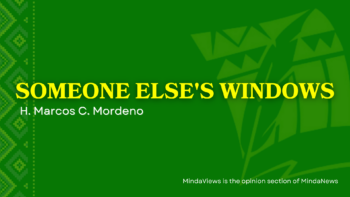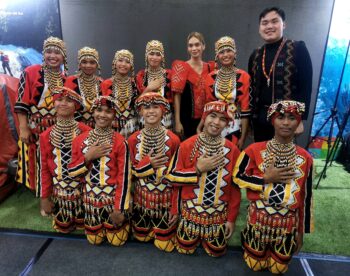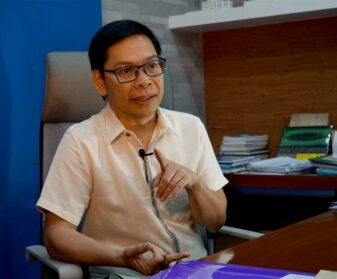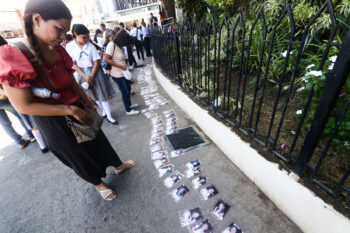METRO MANILA (MindaNews/26 June) — While trying on two pairs of pumps at a department store in Manila, I asked the salesman to help me choose which pair looked better on my feet. He kept convincing me that the pointed-toe pumps were better-looking and “sexier” than the rounded-toe ones to which my response was “Hindi ba dako…” Then I paused mid-sentence. I wanted to ask him whether my feet appeared longer and bigger if I wore the pointed-toe pumps as I have long feet, which were US size 9, not a typical size for Asian women. But because I had difficulties explaining in Tagalog, I automatically code-switched to Bisaya or Cebuano. Exasperated at myself because ever since I arrived in Manila, I have been constantly trying to improve my fluency in Tagalog, learning new words like “kalambibit” (with strange excitement in the process), I quickly apologized to him with a default “Sorry, nagbibisaya ako.” A default response I’ve learned since childhood, sounding like an innocent apology, but insidiously underpinned by the notion that speaking Bisaya is a major disadvantage or weakness.
Having been raised and schooled in a university established by American Thomasites, English was the first language I learned systematically. We were not allowed to speak Bisaya/Cebuano in school and if we were caught speaking in our native tongue, we were fined a few pesos. I was “forced” to learn Filipino (which is for me still Tagalog-based) in school because it was a required subject in the curriculum. But every time, my classmates and I were outside the classroom, no one spoke Filipino or Tagalog. If you were caught speaking it, you’d be teased endlessly for being pretentious. It was only during my undergraduate days in the university, having studied Philippine literature, that I gained a deep respect, almost a romantic one (some kind of guilt) towards my own. Cebuano poetry was a big hit in the 90s. Corazon Almerino, Michael Obenieta, Januar Yap, among others showed me how Bisaya or Cebuano is a sophisticated poetic language and not just the language of the streets often derided for being tacky or “baduy.”
The guy replied: “Ma’am it’s okay. Bisaya man ko! Taga Dumaguete!” He smiled then told me that he is often teased for his accent and for being Bisaya by most of the Tagalog-speaking individuals he has met in the city. “Pero nalipay ko ug garbo gyud nako nga Bisaya napud ang atong presidente. Kay kung binuangan ko, naa koy panagang.” (But I’m happy that I have something to be proud of because our president-elect is Bisaya-speaking and every time I’d be teased for being Bisaya, now I have a shield to fend off the jokes.)
When stereotypes and prejudice are masked as humor
We talked for a while about the discrimination masked as jokes against Bisaya people. He pointed out that in movies and in television, Bisaya people are always stereotypically portrayed as comic characters, someone who belongs to the lower class—a maid or a side-kick jester of the main character. The Bisaya is always dark-skinned and trying hard to speak English or Tagalog with a thick Bisaya accent that’s laughable akin to how African-Americans were portrayed in old Hollywood movies. Who are the famous actresses representing Bisaya-speaking characters? Elizabeth Ramsey came to mind, her appearance always a reason for laughter (curly-haired and dark-skinned), and every time she spoke, people giggled.
I shared with him that earlier that day somewhere, the technician who is from Cebu, made a mistake of saying “weeding sirimony” instead of “wedding ceremony” and immediately the Tagalog staff laughed, remarking “Hoy Bisaya.” It is a normalized reaction, accepted like embodied reflex, a twitch one can’t control. The technician gamely responded “Ganyan talaga kaming mga Bisaya. Sorry na.” Everyone forgot I was right there silently fuming. I’ve never learned a scathing response to jokes about Bisaya accents. I’m too emotional about it, and most of the time I freeze and get tongue-tied; the inner workings of my being colonized regional subject manifesting despite being educated in America and having a quite remarkable set of English vocabulary, hence in such situations, a postcolonial subject whose agency should hold more power than the ones making jokes around me. The irony of it all.
After I told him this story, the salesman noted that perhaps, the Cebuano technician’s response by laughing along was more powerful than getting angry. This observation is not without merit. I remembered how in the academe my professors convinced me that the subaltern can speak, that the master’s tools can dismantle the master’s house, that Medusa’s laughter is powerful enough to silence, that one way to fight hegemony is through cooptation of the very words, representations, used to oppress the marginal. Just like how the African-Americans took back the derogatory term “nigger” and used it as terms of endearment among themselves. But laughter and using popular culture are not enough only because the more one goes along with the inaccurate perceptions of oneself, the more one subconsciously embodies such representation. I secretly disagreed with him but didn’t want to argue so instead, I directed the conversation to the subject of my birthplace Dumaguete and that university by the sea where I received my formal education, where I learned liberation theology, where I read books that everyone couldn’t get their hands on, where I put on the trappings of the civility of middle-class upbringing. It was also a city where the “other” wasn’t always talked about or understood. In the Visayas, Muslims from Mindanao, at least at that time, were considered “barter” people holed up in some ghetto-like area called “barter-trade”, a space occupied by stalls selling shawls, curio ethnic items, and gold jewelry. They were referred to as “moklo” in whispered conversations, feared because of the stereotype of Tausugs going “juramentado” or amok, perceived as warfreaks. When my family moved back to Mindanao, my father’s homeland, I somehow felt that I shed a huge part of myself somewhere in the seas sailing to North Mindanao. Dumaguete city holds a special place in my heart in between aching nostalgia and unexplainable disillusionment. After all, was it Thomas Wolfe who wrote “You Can’t Go Home Again” referring to the notion that one can never go back to older systems of things because places and things don’t stay the same; one can’t go home and escape to time and memory?
Mindanao: A place to accept diversity, a place of despair
The opportunity to travel and to gain good education (reading especially) have given me the privilege of experiencing different cultures so that when faced with what might be considered “other,” my immediate reaction is of curiosity than shock. This I have experienced in most of the times I’ve traveled and lived outside the country in attempts to go beyond notions of national identity and isolationist frameworks, and somehow embracing global citizenship.
But the truth is, it is in Mindanao where I’ve spent most of my adulthood (my 20s) before I ventured out of the country, that I learned the different ways to show acceptance and sensitivity towards different cultures and religions. Conversations among professionals (artists, journalists, researchers, anthropologists, educators, among others) oftentimes focused around such topics of diversity. After all, Mindanao is composed of Muslims or Moros, 18 ethnolinguistic groups that comprised the Lumad, Christian settlers, as well as other sectarian groups. The tripartite concept that was initiated in the 90s is not without critique but historically, it worked as a framework in efforts to establish harmonious peaceful co-existence in the island. Mindanao, at least how I singularly experienced it through the people I’ve met or worked with in organizations that are devoted to change the image of Mindanao as war torn or conflict-ridden, the work I’ve done that allowed me to travel around the entire island, have shaped to be the person I am now. Constantly flawed, constantly curious, constantly wandering and wondering, and constantly advocating for what I consider fair.
It is interesting then that when I left the salesman in the department store to claim my phone that I had repaired in an area where rows of stalls sell counterfeit products and other gadgets, I suddenly heard the Azan or Adhan (the Muslim call to prayer). I looked around to see a group of men bowing on a mat inside that space in the mall. People stared but immediately passed by. I was transfixed not because it was different but because I didn’t expect I would see it in a mall in Manila. (Clearly, my reaction was partly a reflection of my ignorance and biased assumptions of this city).
The sound strangely made me feel at home (wherever that is). It also reminded me of that night when the Grab Car personnel in SM Makati asked customers (me included) if they could allow a foreign Muslim couple with a baby to go first so they could have their Iftar. As it is Ramadan, they had been fasting the entire day until sunset. It was raining hard outside. People wanted to go home but they agreed anyway. That night despite the gloomy weather, I felt a sense of positivity. I was impressed at the display of sensitivity from my fellow Filipinos in a city where I often hear comments about Muslim people having a culture of “beheading” their enemies.
Of course the world isn’t perfect. I have to be constantly reminded of that everyday. As of this writing, somewhere in Sta. Catalina, a baranggay in the city of Zamboanga, a transition site occupied by internally displaced people (groups of Tausug, Badjaos, Bisaya, etc) are living in dire conditions, cramped like sardines in makeshift structures, with no clean water supply, and lacking food. Only 287 bunk houses are available for 1,769 individuals who were displaced last 2013 after the Zamboanga siege. Three years after, there have been little improvement in their situation. This Ramadan season, concerned individuals are trying to raise money for food for their Iftar, also asking for donations for school supplies, books, and medical equipment. This community hasn’t gotten any substantial relief services even from the national government since that fateful day most of their houses were razed to the ground. It is a sad reminder of the lack of concern and attention given to Filipinos in that part of the country.
Picking my battles
With all these layers of systemic problems in mind, I am sometimes forced to feel the need to preach. And always my older mentors advise me over and over to pick my battles. But sometimes, I go astray, lose my composure, and end up lecturing.
Admittedly, I omitted a few details from the story I told the salesman at the mall. When those people laughed at the Cebuano technician’s thick Bisaya accent and mispronunciation of English words, I vowed to myself that next time that happens, I’d scold each one of them.
Once, one of the guys joked at the older woman who was selling jewelry through installment plans that next chance she sells her golden wares she should wear a veil. There was laughter. Another woman joined in: “Hindi sya Muslim. Bombay, 5/6. 5/6.” (She’s not Muslim. She’s Bombay) to which the guy said “Pareho lang yan sila mabaho (They’re all the same, they all smell). Laughter.
I squirmed. Tolerance. I whispered to myself this word over and over. But it was very difficult. I was reminded of that time in Mumbai last year, when sitting on a woven mat, eating dosa at Silver Beach, my Indian friend asked me sincerely if the relations of the Philippines and India is “good.” I asked if he was referring to international relations or something else. He wanted to know how Filipinos perceive Indians because I was the first Filipina he had engaged with in his life despite that he is well-traveled and works as a pilot. Searching for words like grasping for straws, I tried to explain some misconceptions and stereotypes. I refrained from telling him about “Bombay” as a derogatory term used to stereotype Indians in my country. How do I explain “Bombay” and 5/6 to this man who was all too generous to show me around Mumbai formerly called Bombay, with its ancient caves, zooming rickshaws, ancient art and literature, and rich Bollywood film industry, theater, and dance ? This conversation ironically also taking place in a city also not a stranger to historical racial and religious tensions and hurts. I assured him that in terms of international relations, I think the Philippines and India are in good terms. “I wouldn’t have gotten a Visa-on-Arrival if they weren’t, right?” I smiled. Unease boiled in my gut.
In the end, I decided to e-mail the people joking about Muslims and Indians a reminder to be more discerning and sensitive to other races and individuals belonging to an often-maligned religion all over the world. It was the only thing I could think of that displayed a calmer more calculated reaction rather than verbal “scolding” that might, considering my temperament, go off the rails. Part of what I said in the letter was “Did it ever occur to you that I might be Muslim except that I’m not wearing a veil?” I said this only because I thought of how it must be difficult for some of my close Muslim female friends who chose to not wear a hijab to be around such individuals who make fun of Muslims.
After I sent the e-mail, I broke into a cold sweat, anxiety sweeping my entire body. A kind of fear of judgment unexpectedly hit me–the possibility of being judged for being reactionary, for getting angry at something considered trivial by others. Where is your levity, Claire? As I vomit in the restroom, a thought crossed my mind: Was I too onion-skinned? Did I choose my battle well? Should I have done it differently? Ignore then do something more large-scale instead like say a campaign? When does one decide to choose one’s battles when it comes to sensitive issues of intolerance, prejudice, or racism?
I ran out of the building to get some air and lo and behold, I saw two Muslim women wearing black abayas, and somewhere in the corner of my eye I saw three Persian men, and one Indian man trying to buy some pineapples from a street vendor. The tricycle driver asked if I wanted to be pedaled somewhere. The security guard told him to stop accosting me. I heard the grinding of tires, cars moving along the narrow road; the familiar noise of Manila’s streets mixed with a distant hammering of some construction site nearby. But somewhere in my mind, a switch turned on Ally McBeal style (90s reference unavoidable), and music swelled in–a sonic memory of a cacophony of chants from 5 mosques surrounding the area where my Indian friend lived in Mumbai. It was like a round song of sorts looping on and off, a gnawing reminder: “You can never come home again.” (MindaViews is the opinion section of MindaNews. Jean Claire Dy is a writer and media artist. She holds a Masters in Media Studies and Film from the New School University in New York. She has been working on communication and media projects in the Philippines and Southeast Asia)







